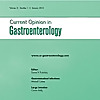
Current Opinion in Gastroenterology
66 FOLLOWERS
Published bimonthly and offering a unique and wide-ranging perspective on the key developments in the field, each issue of Current Opinion in Gastroenterology features hand-picked review articles from our team of expert editors. With twelve disciplines published across the year including gastrointestinal infections, nutrition, and inflammatory bowel disease every issue also contains annotated..
Current Opinion in Gastroenterology
1M ago
Purpose of review To compare different therapeutic modalities and determine their role in the treatment of esophageal achalasia. Recent findings The last 3 decades have seen a significant improvement in the diagnosis and treatment of esophageal achalasia. Conventional manometry has been replaced by high-resolution manometry, which has determined a more precise classification of achalasia in three subtypes, with important treatment implications. Therapy, while still palliative, has evolved tremendously. While pneumatic dilatation was for a long time the main choice of treatment, this approach s ..read more
Current Opinion in Gastroenterology
1M ago
Purpose of review Symptoms/complications related to extraesophageal reflux (EER) are increasingly prevalent presentations and pose significant challenges for clinicians. We summarize and discuss clinical advances and developments in pathophysiology, testing and treatment algorithms of upper/lower airway manifestations of EER. Recent findings Growing evidence supports likely multifactorial causes of laryngeal symptoms, including EER, oropharyngeal pathologies, allergic conditions, and cognitive-affective processes (brain-larynx interaction). Diagnostic paradigm for laryngopharyngeal reflux (LPR ..read more
Current Opinion in Gastroenterology
1M ago
Purpose of review To provide an overview of the current literature regarding the use of advanced combination therapy (ACT) in patients with inflammatory bowel disease (IBD). Although the treatment of IBD has come a long way, many patients do not respond or will lose response to currently available treatments over time. ACT has been proposed as a model to create sustained remission in difficult-to-treat IBD patient populations. This review discusses the available literature supporting the use of ACT, followed by practical tips for applying this model of treatment to clinical practice. Recent fi ..read more
Current Opinion in Gastroenterology
1M ago
Purpose of review Barrett's esophagus (BE) is the number one risk factor for developing esophageal adenocarcinoma (EAC), a deadly cancer with limited treatment options that has been increasing in incidence in the US. In this report, we discuss current studies on the role of mesenchyme and cancer-associated fibroblasts (CAFs) in BE and EAC, and we highlight translational prospects of targeting these cells. Recent findings New insights through studies using single-cell RNA sequencing (sc-RNA seq) have revealed an important emerging role of the mesenchyme in developmental signaling and cancer ini ..read more
Current Opinion in Gastroenterology
1M ago
Purpose of review Inflammatory bowel diseases (IBD) are associated with several well described neoplastic and structural complications. Increasing disease prevalence, healthcare barriers, and medication refractory phenotypes contribute to ongoing complications despite significant strides in medical management. Enhancements in endoscopic technology and techniques have allowed a minimally invasive approach for what has historically required surgery. In this article, we review the current and future landscape of endoscopic IBD intervention. Recent findings Endoscopic resection is the first line f ..read more
Current Opinion in Gastroenterology
1M ago
Purpose of review Eosinophilic esophagitis (EoE) is a Th2 immune/antigen-mediated disorder characterized by esophageal dysfunction and eosinophilic inflammation. Worsening dysphagia and food impactions are significant complications associated with esophageal remodeling and fibrostenotic disease. This review highlights the most recent research findings pertaining to mechanisms of sub-epithelial fibrosis in EoE, current diagnostic tools, and therapeutic approaches. Recent findings Recent studies leveraging publicly available single cell sequencing databases and comparative proteomics have furthe ..read more
Current Opinion in Gastroenterology
1M ago
Purpose of review To review recent publications on the inability to belch syndrome. Recent findings Five recent retrospective case series indicate that the inability to belch syndrome usually starts in early childhood and is often accompanied by gurgling noises in the chest, pain in the chest or upper abdomen, bloating, and excessive flatulence. Currently, the vast majority of patients who have been identified with inability to belch have self-diagnosed the syndrome on the basis of information available on the internet. A favorable response to injection of botulinum toxin in the cricopharyngeu ..read more
Current Opinion in Gastroenterology
1M ago
Purpose of review This review aims to discuss recent advancements in the endoscopic management of early esophageal adenocarcinoma (T1 EAC). Recent findings Patients with high-risk EAC (defined by the presence of deep submucosal invasion, and/or lymphovascular invasion, and/or poor differentiation) have a higher risk of lymph node metastases than those with low-risk EAC. However, more recent, endoscopically-focused studies report a lower risk of lymph node metastases and distant metastases for high-risk EAC than previously assumed. Instead of referring all high-risk EAC patients for esophagecto ..read more